ARLINGTON NATIONAL CEMETERY, Va. (April 26, 2010) -- A lone Soldier stands on an open plaza, buffeted by bone-chilling wind. Twenty-one steps. Turn. Stand at attention for 21 seconds. Turn. Repeat. The sun drops. The temperature falls. The crowds depart. The Soldier continues his solitary walk.
The cemetery closes at 5 p.m., but closing brings little relief. The Soldier is only 12 hours into a 27-hour shift. He has spent every other hour marching in the bitter cold, and still has a long, frigid night of training on the plaza before he can go home at seven the next morning.
None of this fazes the Soldier, for he is a sentinel, a guard at the Tomb of the Unknowns at Arlington National Cemetery. He has one of the most sacred missions in the military, and he would walk through fire to honor and protect the fallen, nameless Soldiers under his watch.
In the early 1920s, the modern world was still emerging, shell-shocked, from World War I. The "war to end all wars" had claimed entire countries, monarchies and an untold number of lives, many who are still nameless and faceless.
Following the examples of allies like Great Britain and France, Congress approved a resolution to ceremonially honor and bury one of America's countless unknown World War I casualties in a special tomb at Arlington National Cemetery, Va., in 1921. The Tomb of the Unknown Soldier was dedicated that Nov. 11-then known as Armistice Day-by President Warren G. Harding, with the inscription: "Here Rests In Honored Glory An American Soldier Known But To God."
It was an emotional, touching precedent and unknown, fallen servicemembers from World War II, the Korean War and Vietnam were later interred at the tomb with full military honors. The servicemembers were chosen randomly from unmarked graves at U.S. cemeteries, with final selections made by highly decorated veterans. Each of the unknowns has been ceremonially awarded the Medal of Honor and other decorations, such as Britain's Victoria Cross and Belgium's and France's Croix de Guerre. (Note: The unknown from Vietnam was identified as Air Force 1st Lt. Michael Blassie in 1998, although a marker remains in honor of all the missing and unidentified servicemen from that war.)
Guards were first posted at the tomb in 1926, after one too many tourists had used the grave as a picnic table. In the years since, their duties and hours have increased, and the Changing of the Guard has become a "must-see" on the Washington tourist circuit.
But those who guard the tomb (members of the 3rd U.S. Infantry Regiment, better known as "The Old Guard") don't want to be known as performers. They exist to "pay respects to the unknown Soldiers," said Staff Sgt. Kevin Gilliam, the 1st Relief commander at the tomb.
"To me, (the tomb) symbolizes the ultimate sacrifice," he continued. "Every time I look out there, I look at three guys who gave up everything. They lost not just their lives, but their identities. And also, what their families are sacrificing too, not having the peace of mind, knowing that 'My son is in Section 60 in Arlington National Cemetery.' They're never going to know."
Gilliam was compelled to become a tomb guard after attending the funerals of friends from the 3rd Infantry Division he had deployed with to Iraq. He saw the pain their families endured, and after visiting the tomb, realized that the guards take the place of the unknowns' families. This was something he could do. He could honor and remember them in place of all the families who never knew what happened to their sons, husbands, fathers or brothers.
"You see families who are coming straight from Section 60 (where servicemembers killed in Iraq and Afghanistan are interred) from a funeral, and they've got tears in their eyes. Veterans Day, Memorial Day-it really hits home, what we're out here for. It's definitely not for ourselves, (but) just to pay homage to those who came before us," he explained.
"I get to represent my fallen comrades and my fellow Soldiers everywhere," added Spc. Joseph Hull, one of the sentinels. "It means a lot to me. I'll definitely carry it with me the rest of my career."
It's not an easy job. A Soldier has to be driven to endure the 27-hour days and weather extremes. After enlisting, then volunteering and being selected for The Old Guard, Soldiers can eventually try out for one of 27 sentinel positions. Less than 20 percent of Soldiers typically make it; in Gilliam's class of 16, only he and one other Soldier passed. According to the Society of the Honor Guard, Tomb of the Unknown Soldier, since 1959, only about 570 Soldiers have been awarded the coveted Tomb Guard Identification Badge.
Tomb guards are assigned to one of three reliefs (depending on their height), and can spend anywhere from six to nine months training to become an official sentinel, perfecting their marching, military history and uniforms. Much of the training is done on the plaza in front of the tomb, in real time, exactly as they would conduct an actual walk or guard change. The only difference: the cemetery is closed and it's usually the middle of the night.
"You do training during the day...manual, uniform, uniform classes. And then at night you get your hours of training in. The guards who are posted at night aren't a ceremonial guard. They're in ACUs. So they're working on walking the mat, perfecting their lines, angles. We also do training as a whole. The whole squad will go out at night and train the guard changes and things like that," said Gilliam, who as a relief commander actually conducts the training, and changes the guard rather than walking the mat.
It's exhausting, the guards say, but they push through it. Hull had a newborn daughter during his training, so he had an especially hard time. In fact, he hopes to go to special-operations training, and expects his sleep-deprivation practice and discipline as a tomb guard will help him.
In addition to honoring the unknowns and all of the fallen, the sentinels represent the Army to the American public. They're required to get two hair cuts in a nine-day work schedule and unlike most Soldiers, the sentinels are issued four dress uniforms and use an industrial-strength steam press. According to Hull, they spend up to six hours a day preparing uniforms, and four shining dress shoes, and that's once a Soldier has it down to a science. It can take a guard in training twice as long.
The guard is changed every hour during the winter and every half-hour during the summer months. At the top of the hour (or half-hour), a relief commander, like Gilliam, salutes the tomb and announces the change. "Ladies and gentlemen, may I have your attention please. I am (name and rank) of the 3rd Infantry Regiment, United States Army, commander of the relief, Tomb of the Unknown Soldier. The ceremony you are about to witness, is the Changing of the Guard. In keeping with the dignity of this ceremony, it is requested that everyone remain silent, and standing. Thank you."
He inspects the oncoming Soldier and his weapon (depending on whether he wears cold-weather gloves, which prohibit a complete weapon inspection), then he and the new Soldier meet the retiring sentinel in front of the tomb and all three salute the unknowns.
"Pass on your orders," the relief commander, who is the only Soldier entitled to wear rank insignia, directs the relieved sentinel, according to the tomb's standard operating procedures.
The relieved sentinel then tells his replacement: "Post and orders remain as directed."
"Orders acknowledged," the new sentinel replies before beginning his patrol.
"I've done over 800 walks and about 150 guard changes, so it's become a habit," said Spc. Kristopher Mancha, another guard. "But I try to keep that in the back of my mind, that just because it's a habit, I'm never comfortable when I come outside. I'm constantly thinking and trying to do my best, never just going through the motions. But sometimes we do make mistakes, whether the crowd notices or not. We're never perfect. We always try to strive for perfection, but deep down inside, we're never perfect."
The sentinels also never get over the sense of awe they feel on their first walk in front of the tomb. They have the same nerves, the same butterflies each time.
"It was an impressive sight and definitely a very humbling one. I was speechless when I first saw it and I really didn't know what to say. It still feels the same," said Hull. "It represents a lot to me. It definitely represents my fallen brothers and sisters in the military and the armed services. I do know people who are here in the cemetery and are buried, and my entire family served in the military, so it's just kind of instilled in me." Hull has served at the tomb for three years, and said each day is like his first.
The "mat"-the 63-foot area in front of the tomb where the guards walk-is sacred, so sacred that if the crowd gets rowdy or noisy, the guard will step off the mat before asking for silence and respect. Otherwise, he follows a carefully prescribed routine.
"What we do for our entire post, we take 21 steps across the mat, turn and face D.C. for 21 seconds, turn back, face down the mat, change shoulders and do that process over and over again. Twenty-one alludes to the 21-gun salute, which is the highest military honor. So we give them that salute as many times as we can during the hour or half hour," Gilliam explained.
"There's no markers," added Mancha. "It's been said before that you can go out here and change the guard blindfolded. There's rust marks on the plaza. Sometimes they get washed off.... It actually shows the steps from the rust on the bottom of our shoes. It shows the tradition that we've been taking the same steps for a couple decades. We don't rely on those rust marks because I'm not looking down.... I'm looking straight ahead at all times."
Mentally ticking off 21 seconds also becomes instinctive, helped by a clock sentinels-in-training spend "lots of time looking at," Hull added.
The sentinels stand watch over the three unknown Soldiers 365 days a year, through pouring rain, blizzard-like snow and scorching heat. And they do it in all-wool dress uniforms. They can add cold weather gear or rain gear, but can't change into lighter uniforms during Washington's notoriously hot and humid summers.
"We try to take as many precautions to prepare for it as we can," said Gilliam. "But part of it is, you just have to tough it out. Wintertime to me-I don't like the cold at all-so the wintertime is a lot tougher than the summer. Summertime is over 100 degrees (in) 100-percent wool (uniforms). It can definitely get pretty hot. We do in the summertime, 30-minute shifts. It's not overwhelming, but you have to prepare your body, stay hydrated. The physical aspect wears down on the Soldiers, especially guys who've been here over two or three summers."
It does have an up side, however, said Mancha. Extreme-weather days are his favorite times guarding the tomb.
"It's actually very motivating, believe it or not," he said. "Some Soldiers like the heat. Some Soldiers like the cold. Snow-snow's an awesome time to walk. There's not a lot of crowd that comes around. That's not what we focus on, but to be out here by yourself, (whether it's) 100 degrees or negative-10, it gets very motivating. You're dreading it at first, but when you get out here and you're by yourself, it's just you and the unknowns, and you're doing something special, something nobody else wanted to do. Guarding the unknowns at 2 a.m. in 10-degree weather, it motivates you.
"I feel this is the least I can do for other Soldiers who are currently deployed..." Mancha continued. "They're sacrificing their lives, their time...for me to be here right now. And for me to not only guard the unknowns, but to bury them here in Arlington National Cemetery, doesn't compare to what they're doing overseas. I consider it the least I can do as an infantryman...in a ceremonial unit...in my first duty station. They're the heroes. We just try to represent them to the world."
History of the tomb and its sentinels
March 4, 1921, Congress approved a resolution providing for the burial of an unidentified American Soldier, following the custom adopted by other allied countries after World War I. The site was to be the plaza of Arlington National Cemetery's Memorial Amphitheater, which had been dedicated the previous year.
On Memorial Day, 1921, an unknown was exhumed from each of four cemeteries in France. The remains were placed in identical caskets and assembled at Chalon sur Marne.
October 24, Sgt. Edward F. Younger, wounded in combat and highly decorated for valor, selected the Unknown Soldier for World War I by placing a spray of white roses on one of the caskets. Those remaining were interred in the Meuse Argonne Cemetery, France. The Unknown Soldier then returned home to the U.S. to lie in state in the Capitol Rotunda until Armistice Day. Nov. 11, 1921, President Warren G. Harding officiated at the interment ceremonies at the amphitheater.
The monument, which rests on top of the Unknown grave, is a sarcophagus, simple, but impressive in its dimensions. Its austere, flat-faced form is relieved at the corners and along the sides by neo-classic pilasters, or columns, set onto the surface.
The three figures of Valor, Victory and Peace are sculpted into the panel, which faces Washington. On the plaza face the words "Here Rests in Honored Glory An American Soldier Known But To God," are inscribed
August 3, 1956, President Dwight D. Eisenhower signed a bill to select and pay tribute to the Unknown Soldiers of World War II and Korea on Memorial Day 1958. The World War II Unknown was selected from 19 remains exhumed from military cemeteries in Hawaii, Europe and the Philippines.
Two Unknowns from World War II, one from the European Theatre and one from the Pacific Theatre, were placed in identical caskets and taken aboard the U.S.S. Canberra, a guided missile cruiser resting off the Virginia capes. Petty Officer 1st Class William R. Carrette, then the Navy's only active-duty Medal of Honor recipient, selected the Unknown Soldier of World War II. The remaining casket received a burial at sea.
Four unknown Americans who lost their lives in Korea were disinterred from the National Cemetery of the Pacific in Hawaii. Master Sgt. Ned Lyle made the final selection. Both caskets arrived in Washington May 28, 1958, where they lay in the Capitol Rotunda until May 30.
That morning they were carried on caissons to Arlington National Cemetery. President Eisenhower awarded each the Medal of Honor, and the Unknowns were interred beside their World War I comrade.
May 28, 1984, President Ronald Reagan presided over the interment ceremony for the Vietnam Unknown servicemember. Like his predecessors, he was laid to rest in the plaza of the tomb during a ceremony that received national coverage.
Since then, DNA testing proved the Vietnam Unknown servicemember's remains were those of Air Force 1st Lt. Michael Joseph Blassie. His remains were returned to his family July 10, 1998, and he was buried in his hometown, St. Louis.
Originally, a civilian watchman was responsible for the security of the Tomb of the Unknowns. Then, March 24, 1926, a military guard from the Washington Provisional Brigade (forerunner of the U.S. Army Military District of Washington) was established during daylight hours. In 1948, the 3rd U.S. Infantry Regiment, "The Old Guard," assumed the post, following the unit's reactivation in the nation's capital. Members of the regiment's Honor Guard continue to perform this duty today.
While on duty, the sentinel crosses a 63-foot rubber-surfaced walkway in exactly 21 steps. He then faces the tomb for 21 seconds, turns again, and pauses an additional 21 seconds before retracing his steps. The number 21 is symbolic of the 21-gun salute.
As a gesture against intrusion on their post, the sentinel always bears his weapon away from the tomb.
Only under exceptional circumstances may the guard speak or alter his silent, measured tour of duty. He will issue a warning if anyone attempts to enter the restricted area around the tomb, but first will halt and bring his rifle to port arms.
The guard wears the Army Dress Blue Uniform, reminiscent of the color and style worn by Soldiers during the late 1800s. Tomb guards wear the Tomb Identification Badge on the right breast pocket. The design is an inverted, open laurel wreath surrounding a representation of the front elevation of the tomb. The words "Honor Guard" are engraved at the base of the badge. A guard leaving after at least nine months of service is entitled to wear the badge as a permanent part of the uniform.
Content in last section (History of the tomb and its sentinels) courtesy of www.army.mil/oldguard.
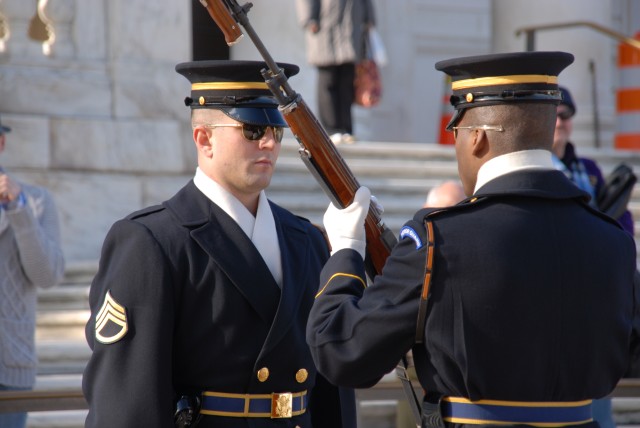

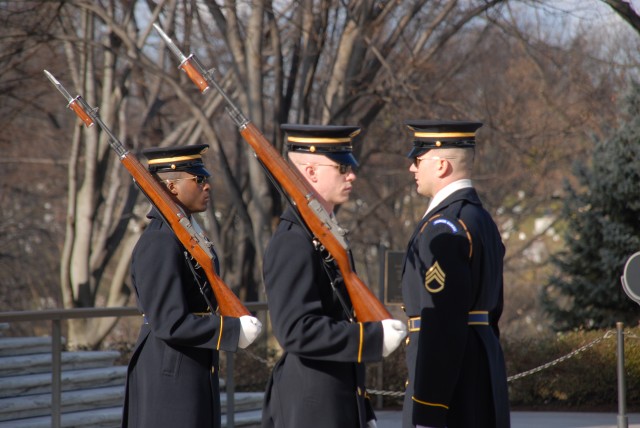
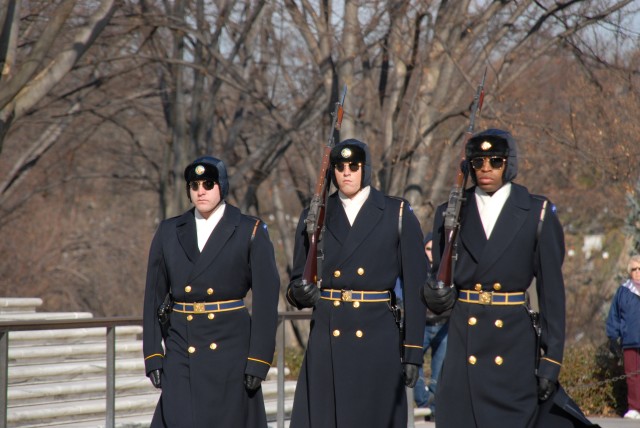
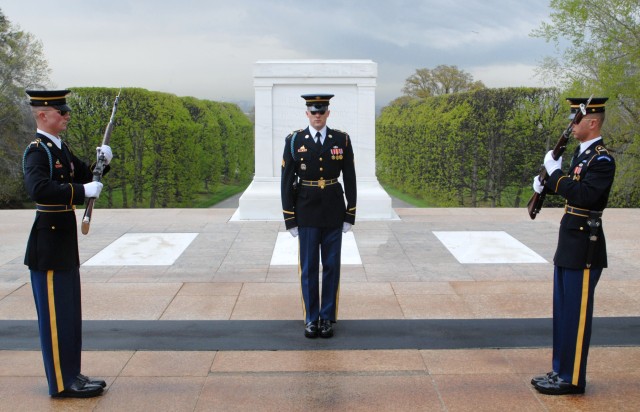

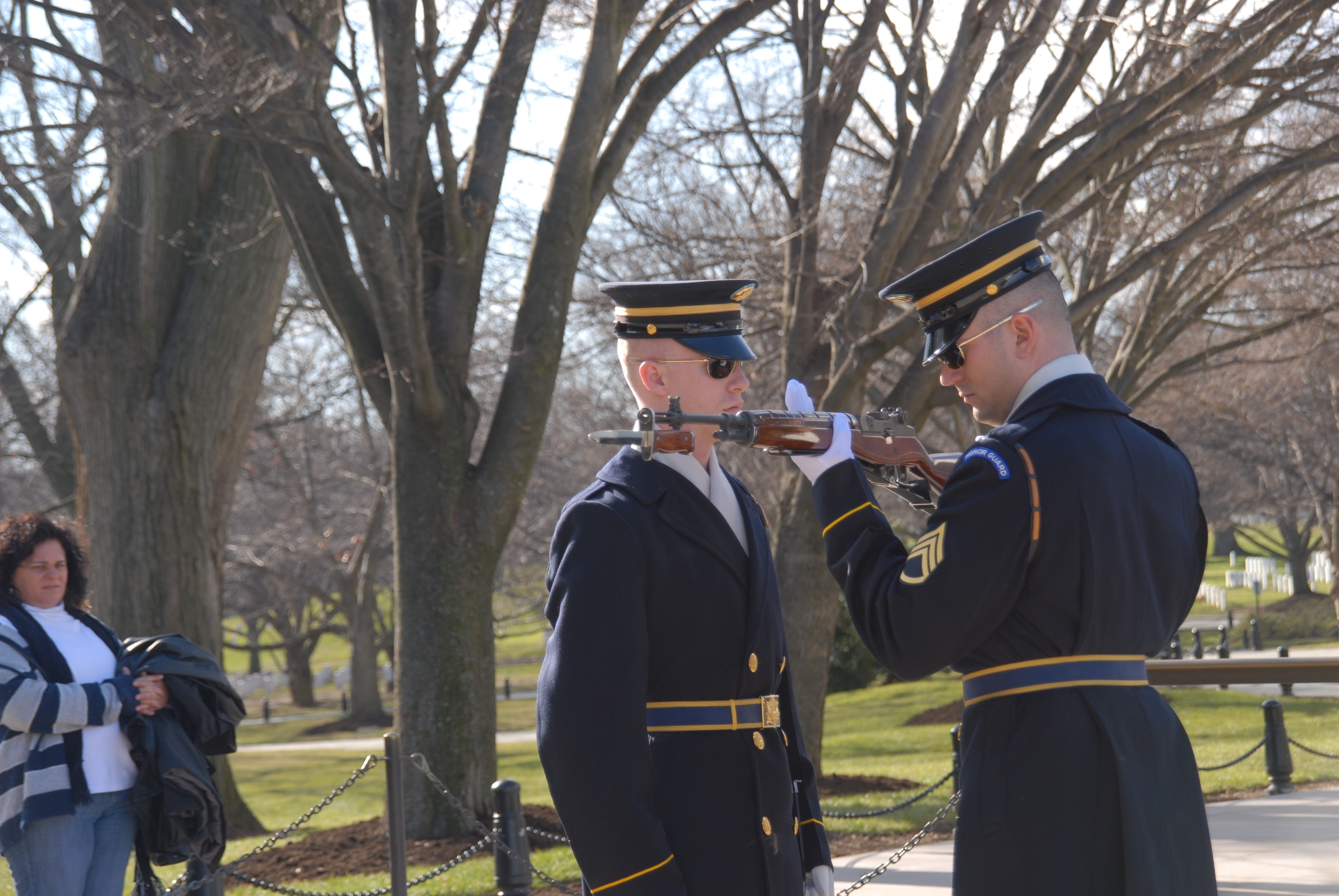


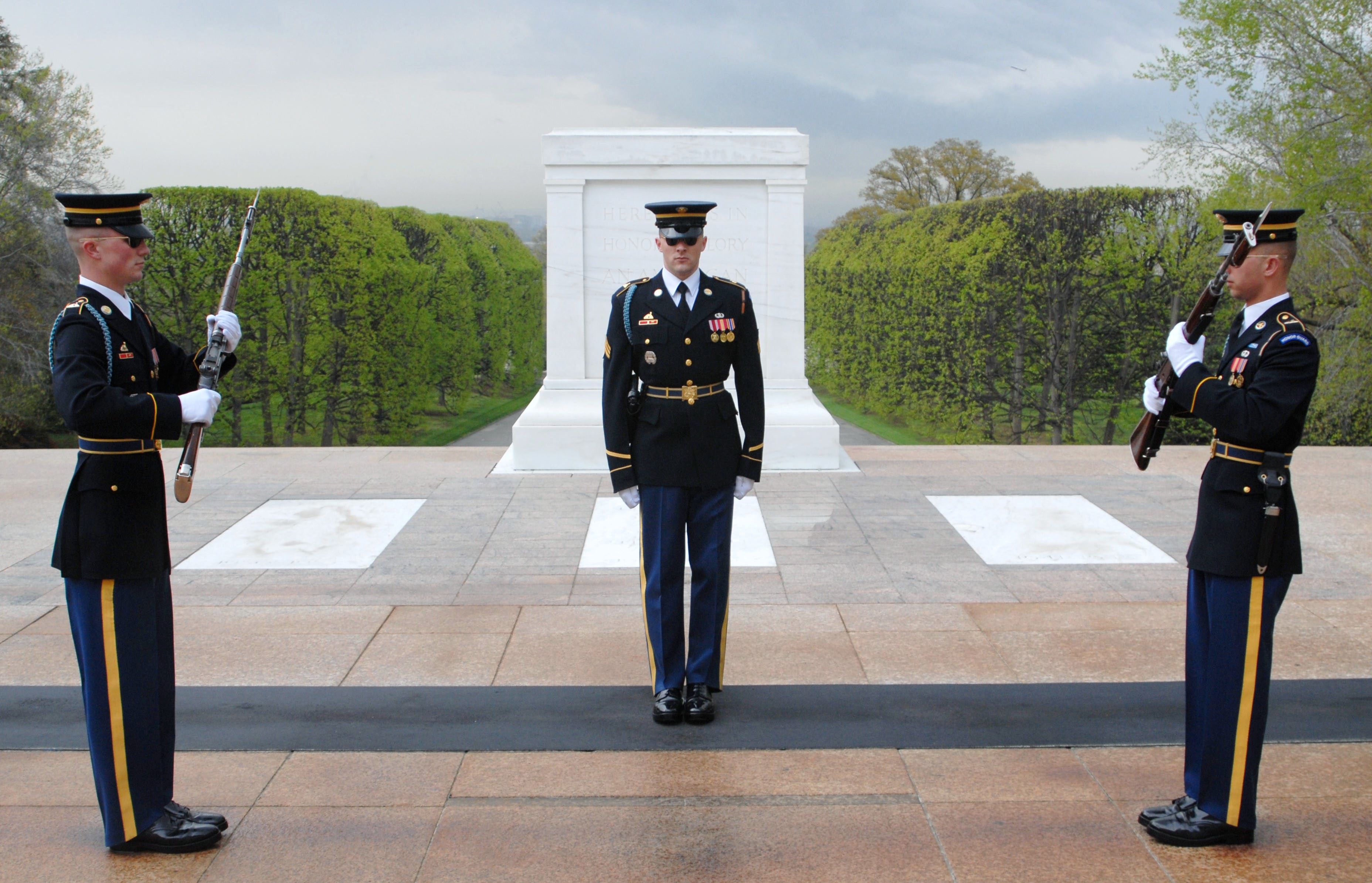
Social Sharing